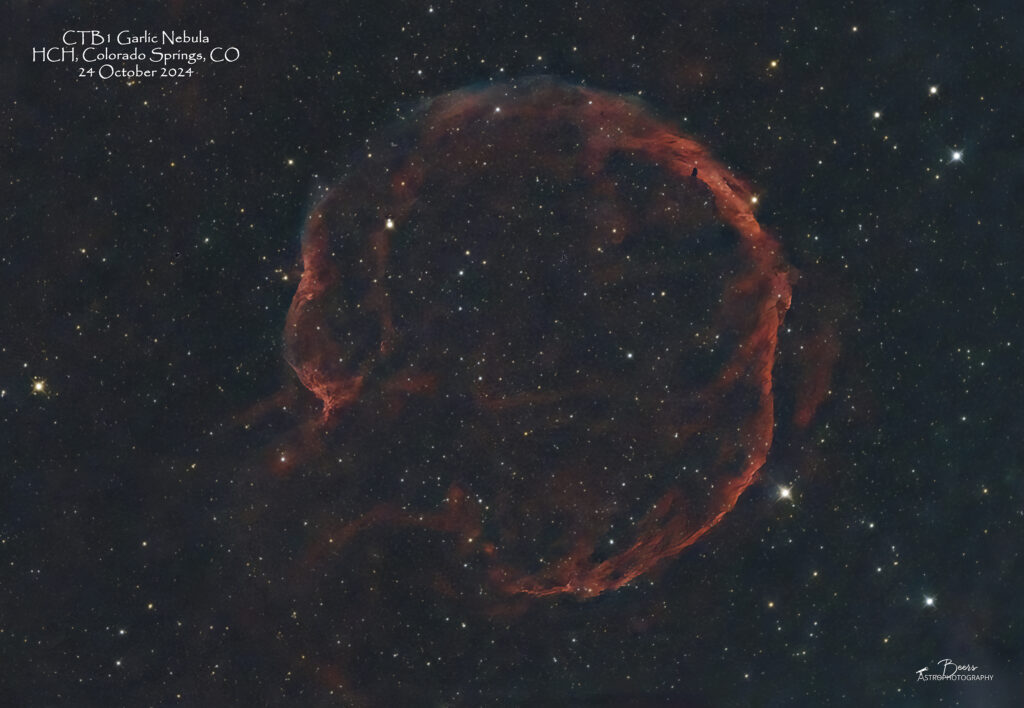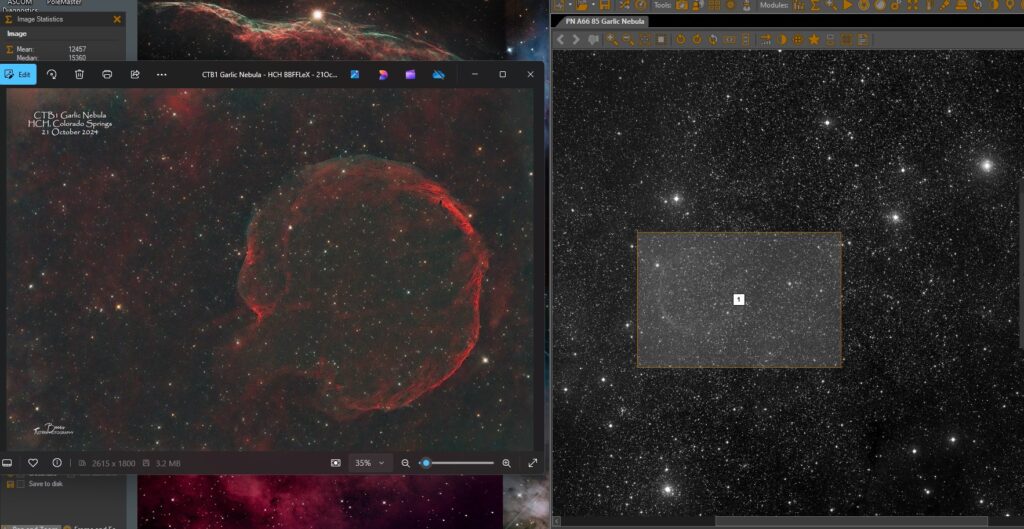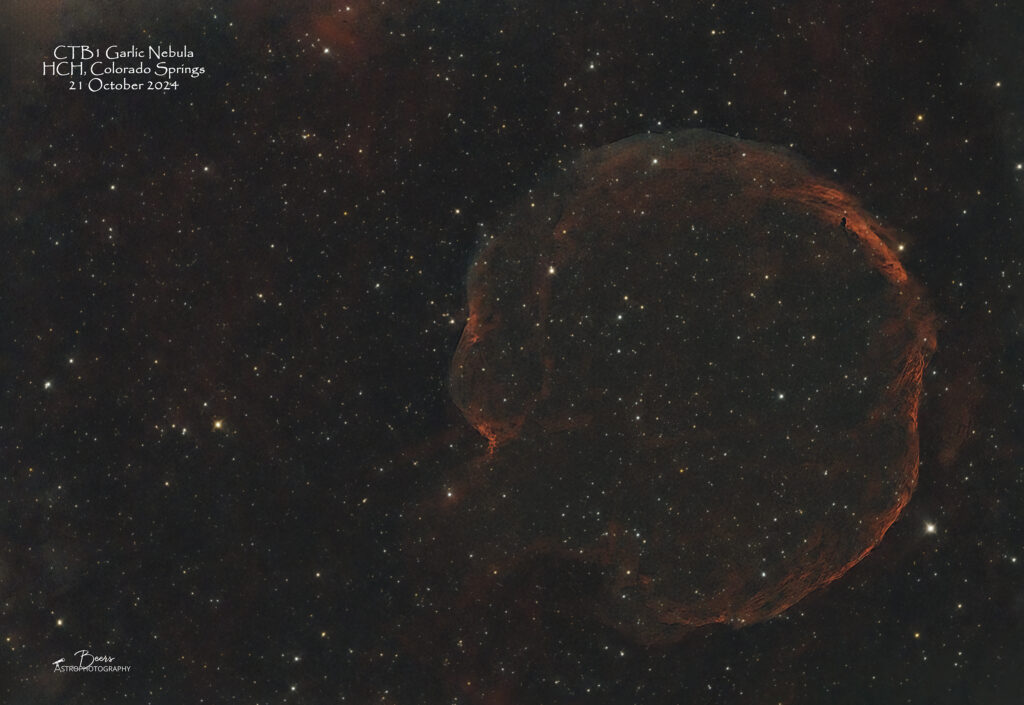I’d added CTB1 Garlic Nebula to my target list last year and planned to capture it this year starting in October. But when I planned the sequence in SGP’s Framing & Mosiac Wizard, I couldn’t see where the nebula was within the star field. So, I built a sequence as best I could, guessing at where the garlic head-shaped nebula was located. As I was doing the trip planning for our October dark skies trip, I decided I didn’t want to spend precious dark skies time capturing the area around/near or just a portion of the DSO. So, I deferred the target from my October dark skies trip’s plan until I could validate the framing during an imaging session from the front patio. This is the result of that framing test…Take #1 (that validated the need for this experiment!) and Take #2 (that dialed in the location!!)

Take #2: 24 October 2024…now I’ve got it!
Thursday (24Oct2024) night gave me the opportunity for a second imaging session at HCH to verify the reframing of CTB1 Garlic Nebula prior to imaging in dark skies.
In addition to reframing the image, I made two other changes to the sequence plan to deal with issues I’d experienced during Monday’s imaging session. First, I turned off the auto meridian flip – since I’ve had periodic issues with it, including during Monday night’s session when it pre-flipped (at the meridian instead of 20 minutes past it as I have designated in the equipment profile) and then denied it had done it! Besides, I always set an alarm to go out to execute the meridian flip on my own (since it’s so finicky about flipping, reacquiring the target, and resuming the autoguider), so having SGP programmed to flip automatically really isn’t necessary. Second, I changed the EAF step size to 150 (throughout the BB/BZ equipment profiles). It had been set to 175, but that seemed to be on the ragged edge of being so out of focus at the extreme ends of the focusing routine that it was causing failures. The data capture overnight worked very well and the new framing (and settings) are what I will use going forward for this DSO.
As illustrated in the Take #2 vs. Take #1 images, I’ve never processed the same image the same way twice! This is essentially the same data, if you disregard the framing. The big difference in the processing was starting with the 30% stretch stacked image (vs. 20% stretch). The rest of the processing steps were pretty much identical. Another processing experiment I’d like to run on these data is to use a Hubble pallet processing. Some of the images I’ve seen have done that which renders the head of garlic a shade of yellow. That may help those of you who are having a hard time seeing/recognizing a head of garlic vs. a brain/brain stem! That will likely not come for awhile – there are many more pressing things on my list of things to do, including first and foremost planning and packing for next weekend’s (hopefully) dark skies trip!
What do you mean you can’t see the nebula within the star field??
Several folks, after reading the first night’s experience regaled in the initial blog, have expressed curiosity (okay…doubts in my visual acuity) about my statement that I couldn’t pick out the Garlic Nebula within the star field in the SGP Framing and Mosaic Wizard (FMW). So, I captured a screenshot of the SGP FMW screen alongside the image that I captured. Pretend that the framing box is not already there and assume that the nebula should be roughly in the center of the presented sky area. Now YOU tell me where it is!!


(Hint – in the reframing I used the two brighter stars that are at the tip of the garlic head as my guide).
As an aside, last night when I was planning sequences for the upcoming dark skies trip – I had the same experience with the SGP FMW presentation of the Dolphin Nebula. I’d already disassembled and packed up Big Bertha for the trip, so I haven’t had a chance to test that framing…I am going to try and image it during the upcoming trip with my WAG framing. Time will tell if I’ve wasted precious dark skies hours or not!
Take #1: 21 October 2024…is the nebula going to be in the frame, or not???

I assembled Big Bertha (still in her case from the October dark skies trip) and set up to image on Monday night, 21 October. My only objective was to validate the framing of this target, so I could image it during our upcoming (hopefully) November dark skies trip, so I imaged it throughout the full night.
During the collection, everything worked smoothly at the beginning of the sequence. It was a little before 20:00MDT when I was up and operating, collecting data on the first subframe. I sat outside and watched a couple of subframe’s collection – hoping that I would get an indication that I had the DSO in the frame…no such luck…nothing was visible in the subframes except the star field. I managed to talk myself into letting it run throughout the night – it’s only bits, it’s from the front patio, no-harm no-foul if there’s nothing but stars in the end, right?.
Keeping with the old adage…it’s always something…I did experience one slight technical glitch. I came out to execute the meridian flip at about 23:00MDT and discovered that the telescope had already flipped on its own at some point before my SGP-directed 20 minutes past the meridian (when I came out there was ~ 6 minutes to go before that point). I let it complete the subframe that it was collecting, and as expected, I got the warning: :”The next subframe’s time is longer than the time to the flip – would you like to execute the meridian flip now?” I thought…sure, why not, let’s see what it does! What it did was lock up the laptop (with another “do you want to pause before the meridian flip” warning hidden behind the main window that was precluding me from executing any commands in SGP). After a number of clicks and bongs, I finally decided to use the ASCOM driver to send the telescope to its park position, disconnect the equipment, reboot the laptop, recycle the power on all the equipment, and restart the sequence. When I did that (thankfully) it reacquired CTB1 on the correct side of the pier and went on its merry way of collecting data flawlessly the rest of the night (including the autofocuser working well!)
When I stacked the subframes, I was pleased to see the garlic head-shaped nebula in the frame! Albeit, not centered correctly, but again, that was the point of this exercise… With a little tweaking of the framing I should be all set for imaging this DSO during our upcoming (fingers crossed Mother Nature cooperates) November dark skies trip over the Halloween weekend. This is definitely a target that I want to image in dark skies. Although there’s not a lot of information or other’s images of it – it is an intriguing object worth some dedicated dark skies time to bring out the richness of its colors and features.
Besides this experimentation and capture adventure story, the images, fun facts, and capture notes (that will sound very much like the description above) are in the gallery at: https://beersastrophotography.com/gallery/ctb1-garlic-nebula/
